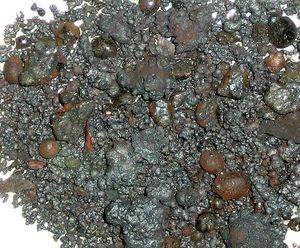Chemistry of p-Block Elements
P-block contains all elements from group 13 to group 18 excluding Helium which is in s-block.
Group 13
Group 13 contains Boron, Aluminum, Gallium, Indium, and Thallium.
Boron(B) is a primary source of Borax (Na2B4O7•10H2O, Hydrated Sodium Borate) which is used as a detergent or in the glass industry as fibre glass.
Aluminum (Al) is a soft, light, reactive metal. Aluminum is the most common metal on Earth composing approximately 8% of the Earth's crust. It is found only in combined form (not as a pure element). The surface of aluminum is protected with a thin coating of Al2O3 (aluminum oxide or alumina). Alumina is used as an abrasive (sandpaper). Al2O3 with trace amounts of transition metal ions give semi-precious stones, like ruby(Al2O3 containing Cr3+), topaz(Al2O3 containing Fe3+), and sapphire (Al2O3 containing Fe3+ and Fe4+).
History of Aluminum. At one time aluminum was more expensive than gold. In 1855, when aluminum was $100 000 per pound, Washington Monument was topped with the world's largest piece of aluminum (3kg). In 1886, the price of aluminum dropped to $5 per pound. Today, at $1 per pound, aluminum is used to make aircrafts and beverage cans.
Production of Aluminum.... Reactions of Aluminum...
Aluminum can form coordination complexes such as Al(H2O)6 and Fe(NH3). Coordination complexes are held together by coordinate covalent bonds between metals and ligands.
Crown ethers are complex Lewis Bases that have been developed to complex metal ions (Lewis Acids). (Ether is a functional groups where oxygen is bonded to two other carbons) Oxygen can bind metal ions particularly in the s-block.
Group 14
Group 14 contains Carbon, Silicon, Germanium, Tin, and Lead.
Carbon(C)
The following are several carbon allotropes introduced in Chemistry 121.
Graphite
When array of carbons each covalently bonded to four other carbons in a tetrahedral structure, the result is diamond.
Buckyball C60 was discovered recently (about 25 years ago). It contains 60 carbon atoms formed by 5 and 6 membered rings in an arrangement similar to a soccer ball. The carbons are covalently bonded similar to diamond and graphite sheets. Between Buckyballs, there are Van der Waal (London dispersion) forces. Buckyballs are perfectly symmetrical, thus non-polar. It contains many electrons (60 x 12) but it solid at room temperature.
Nanotube are hollow tubular structures made of carbon atoms all in 6-membered rings. Buckyballs are used as ends of nanotubes. There are many possible configurations but all nanotubes are considered to be one allotroph. Nanotube are often used to make displays for computer and other electronics.
Silicon(S) is the most abundant element in Earth's crust. It not found naturally pure, but in compound form, mostly with oxygen such as sand and rocks. Silicon forms a diamond-type lattice where each atom is bonded. Silicon is a semiconductor that conducts electricity to some extent).
Isolation and Purification of S:
Group 15
Group 15 contains Nitrogen, Phosphorus, Arsenic, Antimony, and Bismuth
Group 16
Group 16 contains Oxygen, Sulfur, Selenium, Tellurium, and Polonium.
Group 17
Group 17 contains Fluorine, Chlorine, Bromine, Iodine, and Astatine.
Group 18
Group 18 contains Neon, Argon, Krypton, Xenon, and Radon. Group 18 elements have eight valence electrons (a full octet) in their ground state, thus are the most stable atoms on the periodic table.
Helium(He) is the lightest of the noble gases. Due to its low boiling point (4.22K), helium is used as a cryogenic liquid which With only two electrons, helium is non-polar and exerts only weak dispersion forces.
Neon(Ne) is an unreactive gas that is used in neon lights.
Argon(Ar) is used in welding, particularly in aluminum welding to minimize reactions between oxygen and aluminum.
Krypton(Kr) forms compounds such as Kr fluorides
Xenon(Xe) is first made by Niel Barlett at University of British Columbia in 1962 in the form of XePtF6. Until Barlett's discovery, noble gases were called "inert" gases, and thought to be unreactive. Later, more compounds were discovered (XeF2, XeF4, etc. Fluorine usually forms compounds with noble gases due to its extreme electronegativity.

